EX-99.1
Published on May 4, 2020
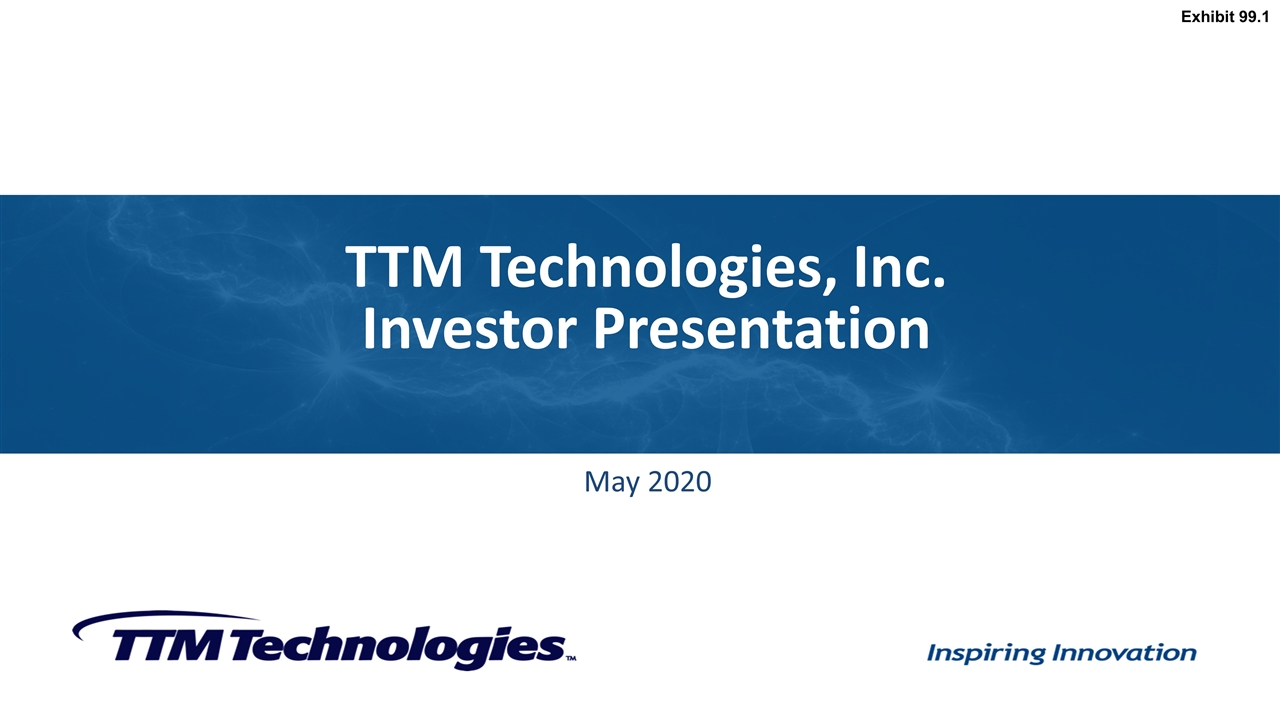
TTM Technologies, Inc. Investor Presentation May 2020 Exhibit 99.1
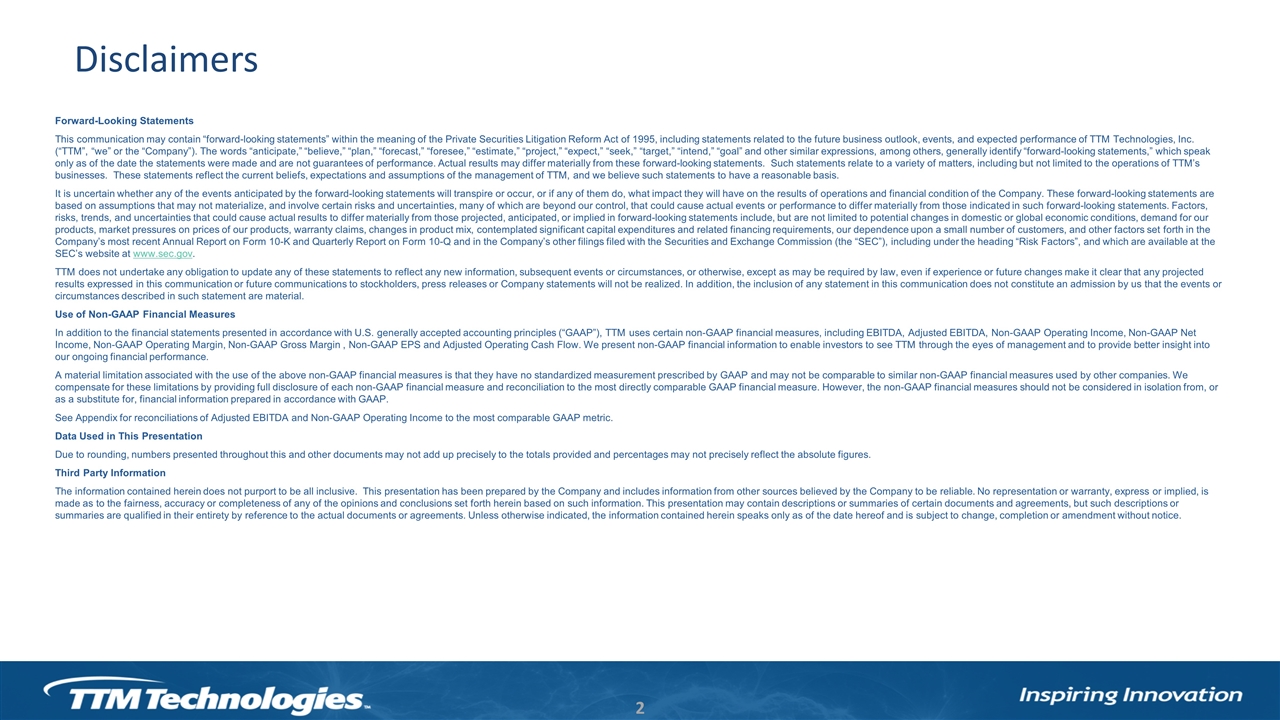
Forward-Looking Statements This communication may contain “forward-looking statements” within the meaning of the Private Securities Litigation Reform Act of 1995, including statements related to the future business outlook, events, and expected performance of TTM Technologies, Inc. (“TTM”, “we” or the “Company”). The words “anticipate,” “believe,” “plan,” “forecast,” “foresee,” “estimate,” “project,” “expect,” “seek,” “target,” “intend,” “goal” and other similar expressions, among others, generally identify “forward-looking statements,” which speak only as of the date the statements were made and are not guarantees of performance. Actual results may differ materially from these forward-looking statements. Such statements relate to a variety of matters, including but not limited to the operations of TTM’s businesses. These statements reflect the current beliefs, expectations and assumptions of the management of TTM, and we believe such statements to have a reasonable basis. It is uncertain whether any of the events anticipated by the forward-looking statements will transpire or occur, or if any of them do, what impact they will have on the results of operations and financial condition of the Company. These forward-looking statements are based on assumptions that may not materialize, and involve certain risks and uncertainties, many of which are beyond our control, that could cause actual events or performance to differ materially from those indicated in such forward-looking statements. Factors, risks, trends, and uncertainties that could cause actual results to differ materially from those projected, anticipated, or implied in forward-looking statements include, but are not limited to potential changes in domestic or global economic conditions, demand for our products, market pressures on prices of our products, warranty claims, changes in product mix, contemplated significant capital expenditures and related financing requirements, our dependence upon a small number of customers, and other factors set forth in the Company’s most recent Annual Report on Form 10-K and Quarterly Report on Form 10-Q and in the Company’s other filings filed with the Securities and Exchange Commission (the “SEC”), including under the heading “Risk Factors”, and which are available at the SEC’s website at www.sec.gov. TTM does not undertake any obligation to update any of these statements to reflect any new information, subsequent events or circumstances, or otherwise, except as may be required by law, even if experience or future changes make it clear that any projected results expressed in this communication or future communications to stockholders, press releases or Company statements will not be realized. In addition, the inclusion of any statement in this communication does not constitute an admission by us that the events or circumstances described in such statement are material. Use of Non-GAAP Financial Measures In addition to the financial statements presented in accordance with U.S. generally accepted accounting principles (“GAAP”), TTM uses certain non-GAAP financial measures, including EBITDA, Adjusted EBITDA, Non-GAAP Operating Income, Non-GAAP Net Income, Non-GAAP Operating Margin, Non-GAAP Gross Margin , Non-GAAP EPS and Adjusted Operating Cash Flow. We present non-GAAP financial information to enable investors to see TTM through the eyes of management and to provide better insight into our ongoing financial performance. A material limitation associated with the use of the above non-GAAP financial measures is that they have no standardized measurement prescribed by GAAP and may not be comparable to similar non-GAAP financial measures used by other companies. We compensate for these limitations by providing full disclosure of each non-GAAP financial measure and reconciliation to the most directly comparable GAAP financial measure. However, the non-GAAP financial measures should not be considered in isolation from, or as a substitute for, financial information prepared in accordance with GAAP. See Appendix for reconciliations of Adjusted EBITDA and Non-GAAP Operating Income to the most comparable GAAP metric. Data Used in This Presentation Due to rounding, numbers presented throughout this and other documents may not add up precisely to the totals provided and percentages may not precisely reflect the absolute figures. Third Party Information The information contained herein does not purport to be all inclusive. This presentation has been prepared by the Company and includes information from other sources believed by the Company to be reliable. No representation or warranty, express or implied, is made as to the fairness, accuracy or completeness of any of the opinions and conclusions set forth herein based on such information. This presentation may contain descriptions or summaries of certain documents and agreements, but such descriptions or summaries are qualified in their entirety by reference to the actual documents or agreements. Unless otherwise indicated, the information contained herein speaks only as of the date hereof and is subject to change, completion or amendment without notice. Disclaimers

Critical supplier to today’s fastest growing technologies such as advanced defense radar, automobile technology and medical device technology Significant global footprint with 26 facilities and 19,500 employees Scale: $2,133 mn FY 2019 revenue Profitability: $285.7 mn FY 2019 Adj. EBITDA1 Technology-enabled end markets and customers Leading PCB, Specialty Components and Technology Solutions Provider 1 See Appendix for reconciliation High end computing and storage systems Networking and communications infrastructure Aerospace and defense Medical imaging and diagnostic equipment Automotive Technology Pro-forma for the Mobility business unit divestiture
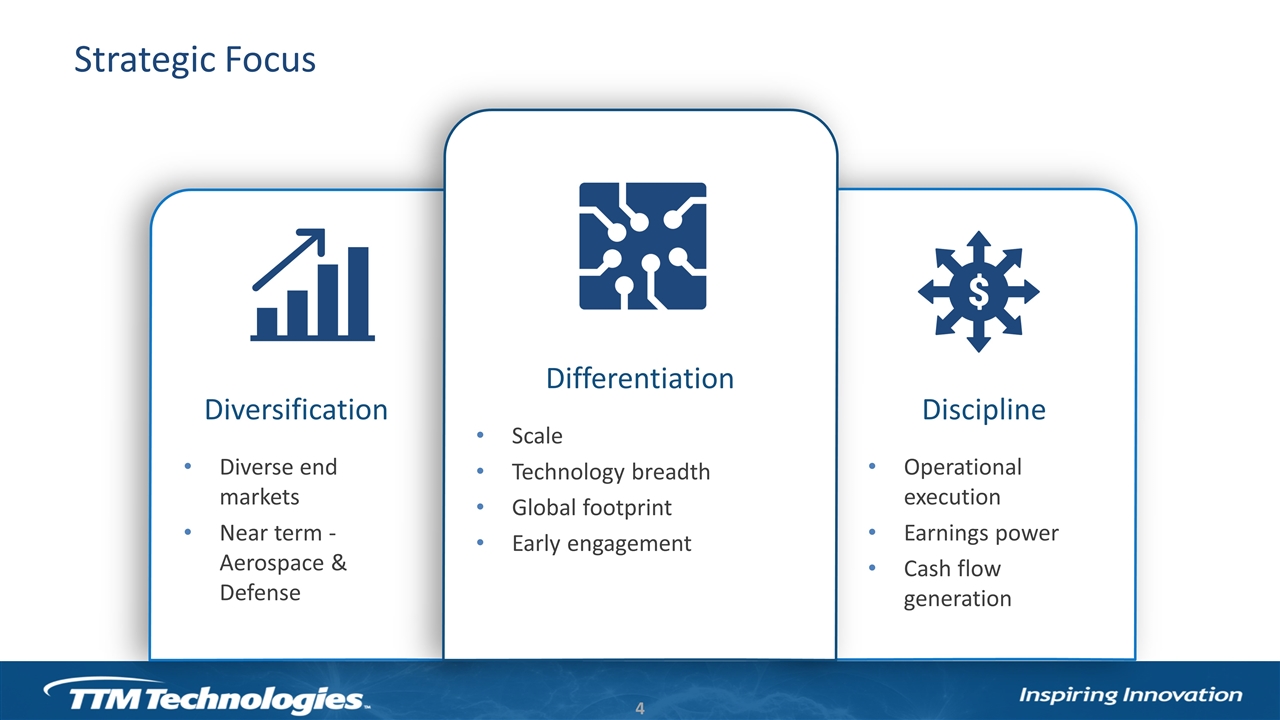
Diversification Diverse end markets Near term -Aerospace & Defense Discipline Operational execution Earnings power Cash flow generation Strategic Focus Differentiation Scale Technology breadth Global footprint Early engagement
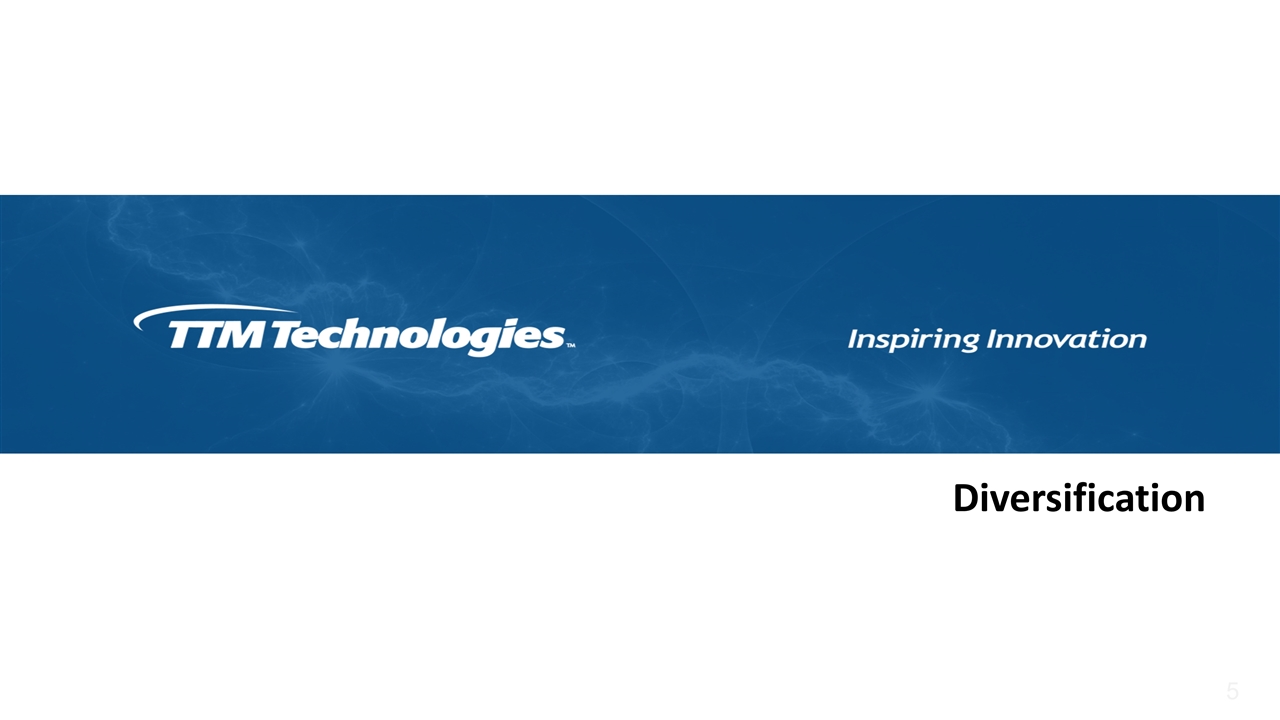
Diversification
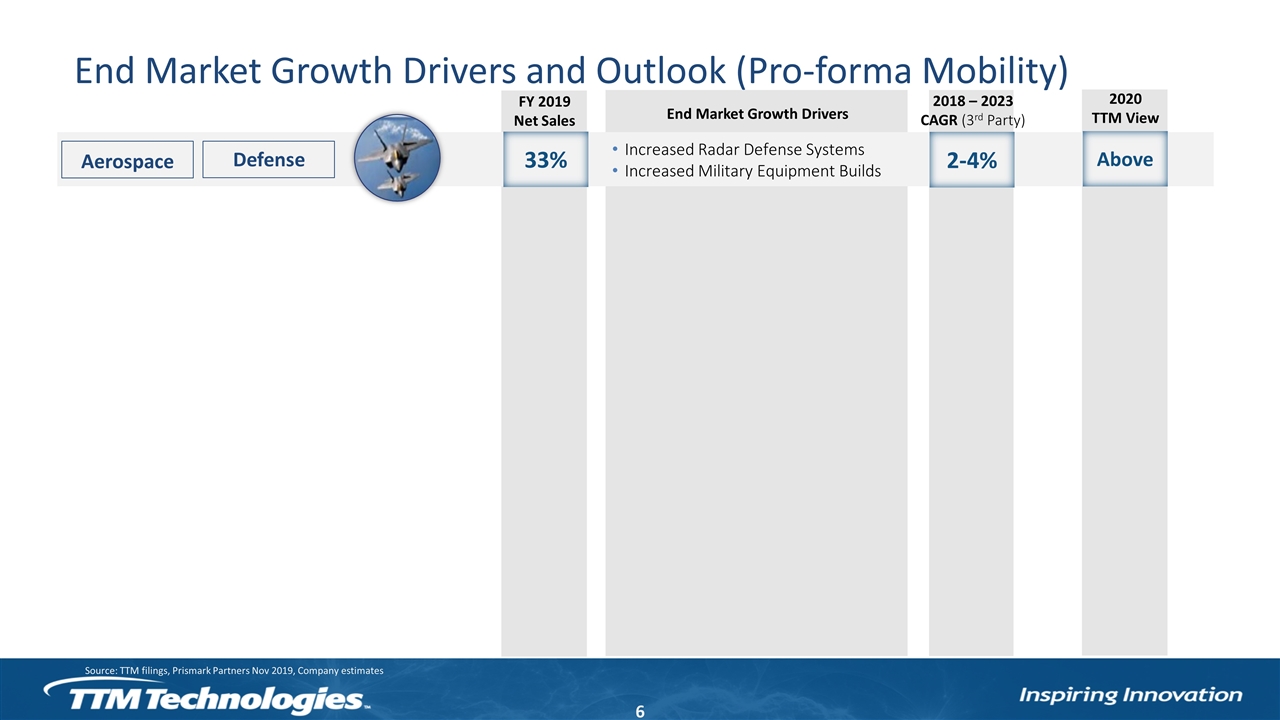
End Market Growth Drivers and Outlook (Pro-forma Mobility) Source: TTM filings, Prismark Partners Nov 2019, Company estimates 33% Increased Radar Defense Systems Increased Military Equipment Builds 2-4% Above Aerospace Defense FY 2019 Net Sales End Market Growth Drivers 2018 – 2023 CAGR (3rd Party) 2020 TTM View

Key Defense Megatrends Increasing Supplier Consolidation Increasing AESA Radar Use Increasing Defense Budgets Key Program ramps M&A and US footprint 18% CAGR AESA Growth 20% Increase FY17-FY19 80 key DoD Program ramps
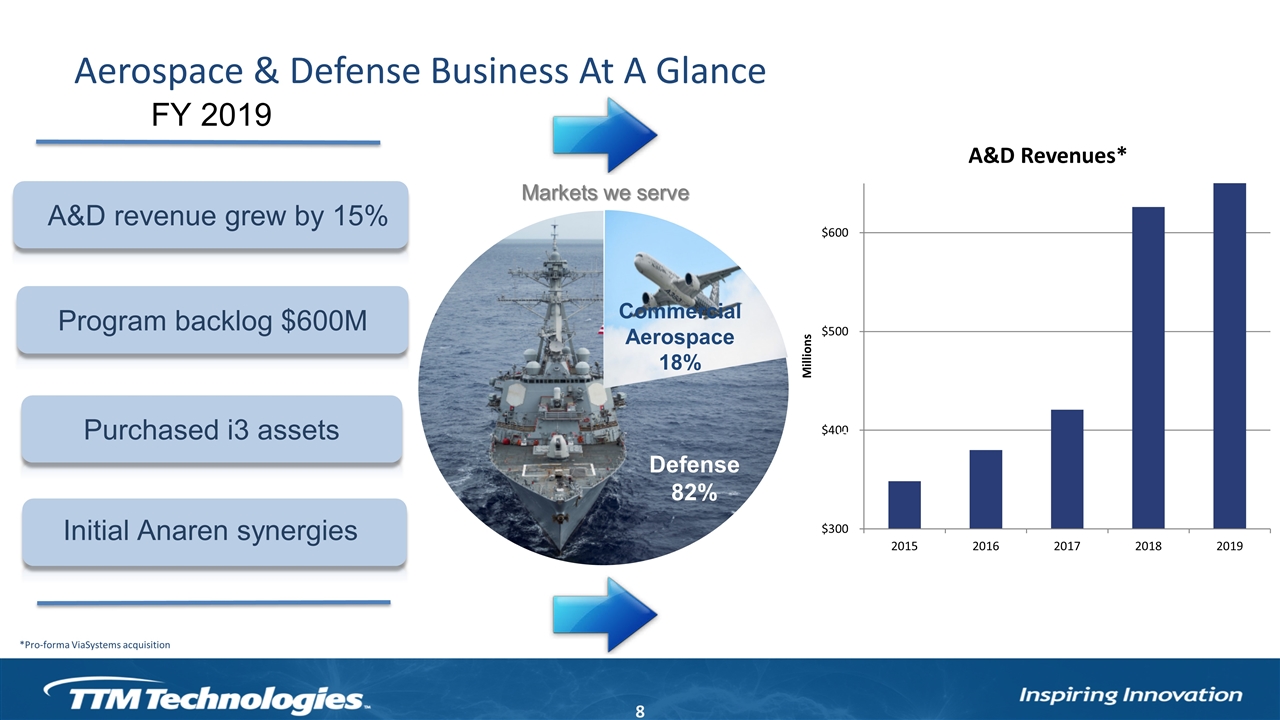
Aerospace & Defense Business At A Glance Focused on Operational Execution A&D revenue grew by 15% Program backlog $600M FY 2019 Initial Anaren synergies Purchased i3 assets Defense 82% Commercial Aerospace 18% Markets we serve *Pro-forma ViaSystems acquisition

Strong Defense Program Alignment F-35 AMDR Q-53 G/ATOR F-16 (SABR) Space Fence LRDR/HDR JCREW LTAMDS Microwave Systems APKWS AMRAAM JDAM JAGM Hellfire Paveway Patriot Standard Missile Missile Systems JTRS Soldier Radio Rifleman Manpack Project X Multi Channel Hand Held (MCHH) Communication Systems Orion GPS III MSP OPIR ESS/PTS Viasat-3 GEO Comm Space Systems Proprietary and Confidential
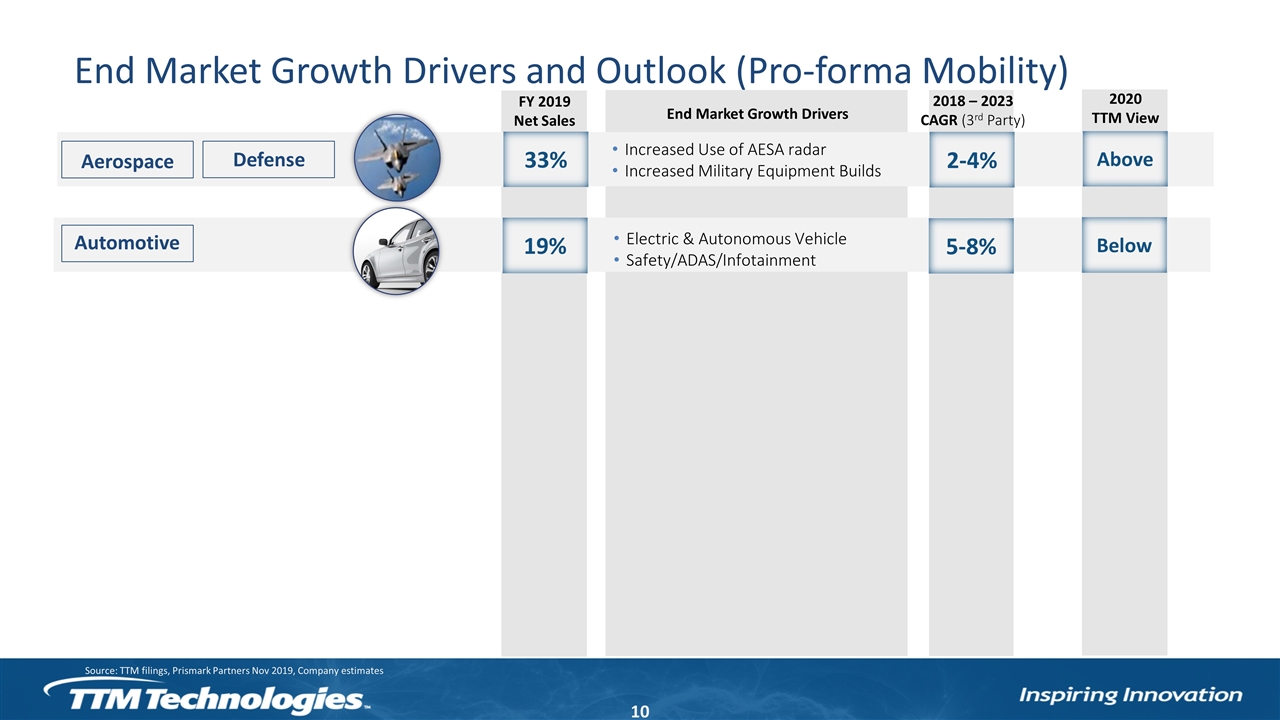
End Market Growth Drivers and Outlook (Pro-forma Mobility) Source: TTM filings, Prismark Partners Nov 2019, Company estimates 33% Increased Use of AESA radar Increased Military Equipment Builds 2-4% Above Aerospace Defense 19% Electric & Autonomous Vehicle Safety/ADAS/Infotainment 5-8% Below Automotive FY 2019 Net Sales End Market Growth Drivers 2018 – 2023 CAGR (3rd Party) 2020 TTM View
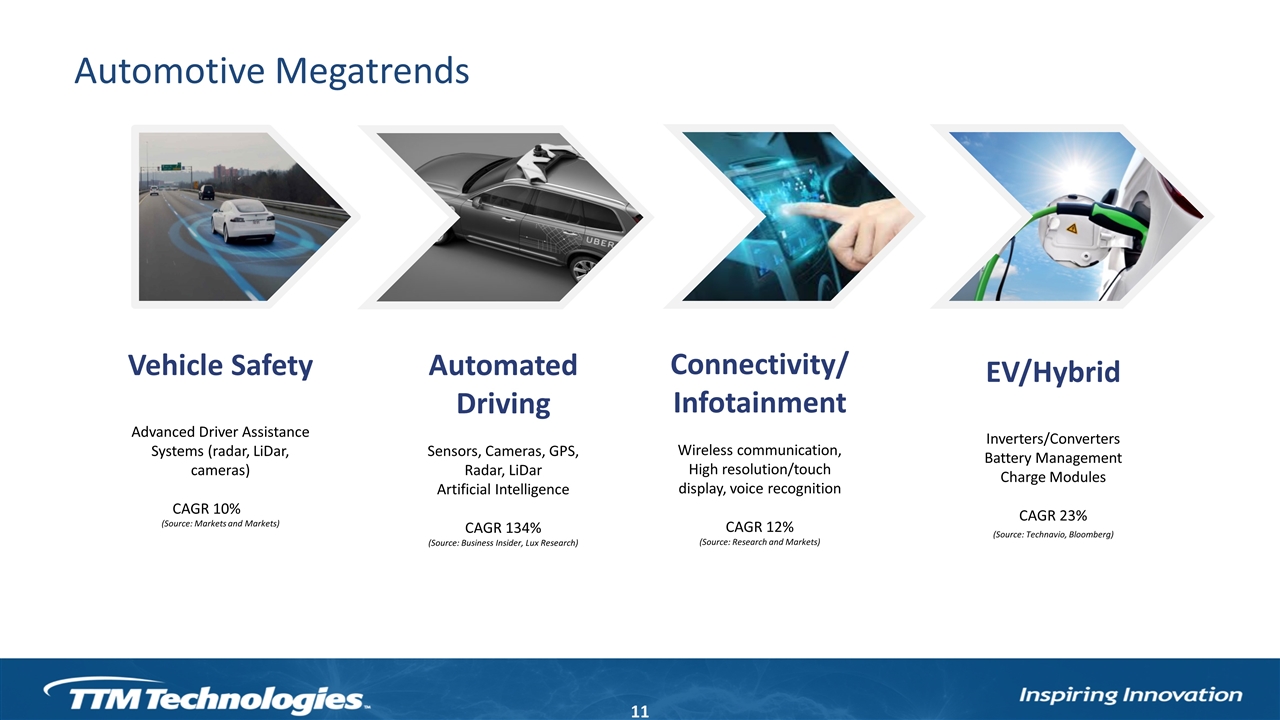
Automotive Megatrends Vehicle Safety Advanced Driver Assistance Systems (radar, LiDar, cameras) CAGR 10% (Source: Markets and Markets) Automated Driving Sensors, Cameras, GPS, Radar, LiDar Artificial Intelligence CAGR 134% (Source: Business Insider, Lux Research) Connectivity/ Infotainment Wireless communication, High resolution/touch display, voice recognition CAGR 12% (Source: Research and Markets) EV/Hybrid Inverters/Converters Battery Management Charge Modules CAGR 23% (Source: Technavio, Bloomberg)

Drives Increasing Electronic Content PCB Usage per Car Type Sq. Meter USD MM units Compact 0.4 – 0.5 30– 40 ~ 36.4 Mid-Range 0.5 – 0.8 50 – 70 ~ 56.4 Luxury 1.5 – 3.0 100 - 150 ~ 7.2 Source: NTI Digest, October 2019 -0.1% CAGR 8.0% CAGR 7.9% CAGR Average PCB content per vehicle $63 in 2016 to $85 in 2020
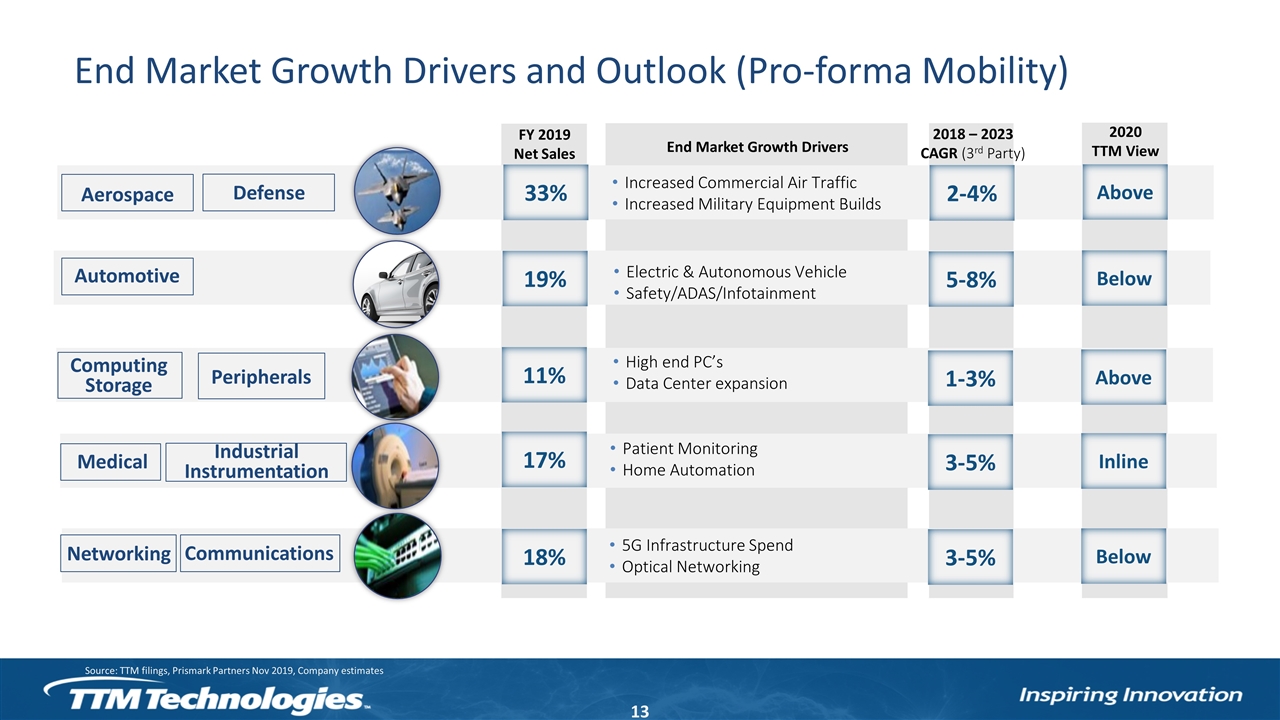
End Market Growth Drivers and Outlook (Pro-forma Mobility) Source: TTM filings, Prismark Partners Nov 2019, Company estimates 33% Increased Commercial Air Traffic Increased Military Equipment Builds 2-4% Above Aerospace Defense 19% Electric & Autonomous Vehicle Safety/ADAS/Infotainment 5-8% Below Automotive 11% High end PC’s Data Center expansion 1-3% Above Computing Storage Peripherals 17% Patient Monitoring Home Automation 3-5% Inline Medical Industrial Instrumentation 18% 5G Infrastructure Spend Optical Networking 3-5% Below Networking Communications FY 2019 Net Sales End Market Growth Drivers 2018 – 2023 CAGR (3rd Party) 2020 TTM View

Differentiation
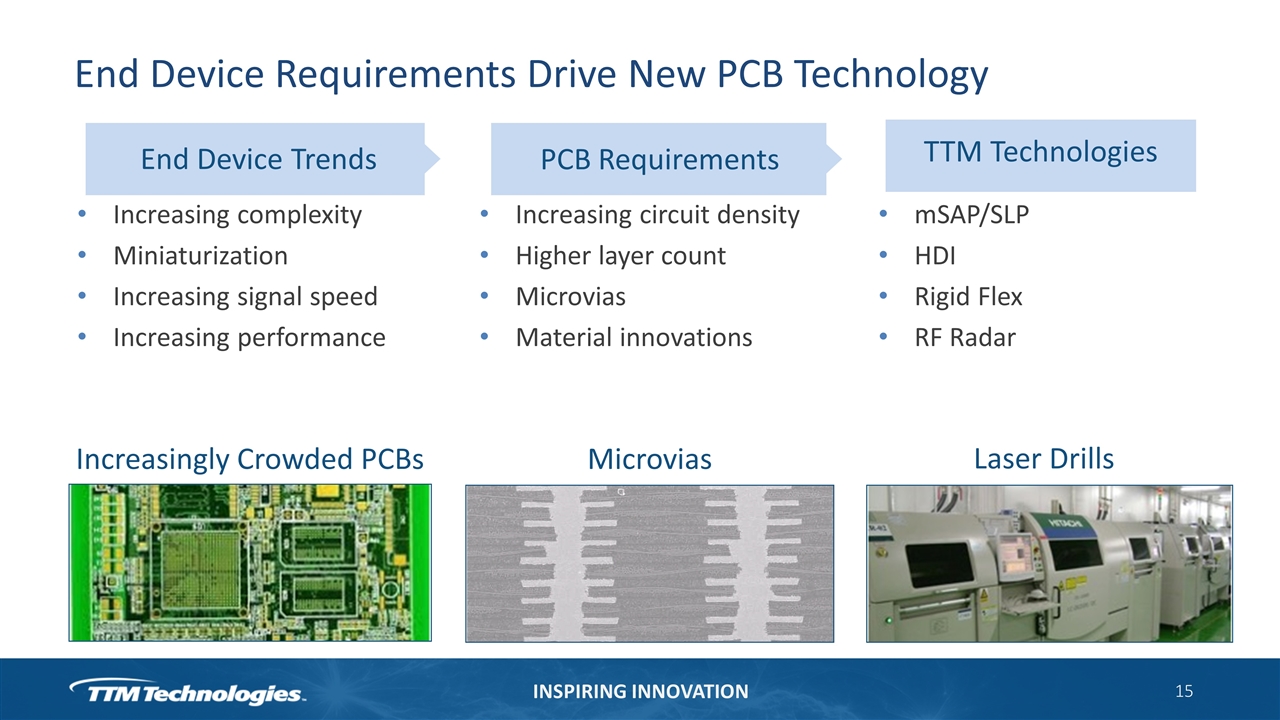
End Device Requirements Drive New PCB Technology Increasing complexity Miniaturization Increasing signal speed Increasing performance Increasing circuit density Higher layer count Microvias Material innovations mSAP/SLP HDI Rigid Flex RF Radar End Device Trends PCB Requirements TTM Technologies Laser Drills Microvias Increasingly Crowded PCBs

TTM Provides Differentiated, Complementary Capabilities High Performance Sub-Assemblies RF engineering strength complements TTM manufacturing strength PCB Substrate RF Engineering/Customer Engagement RF Components RF Design and Simulation
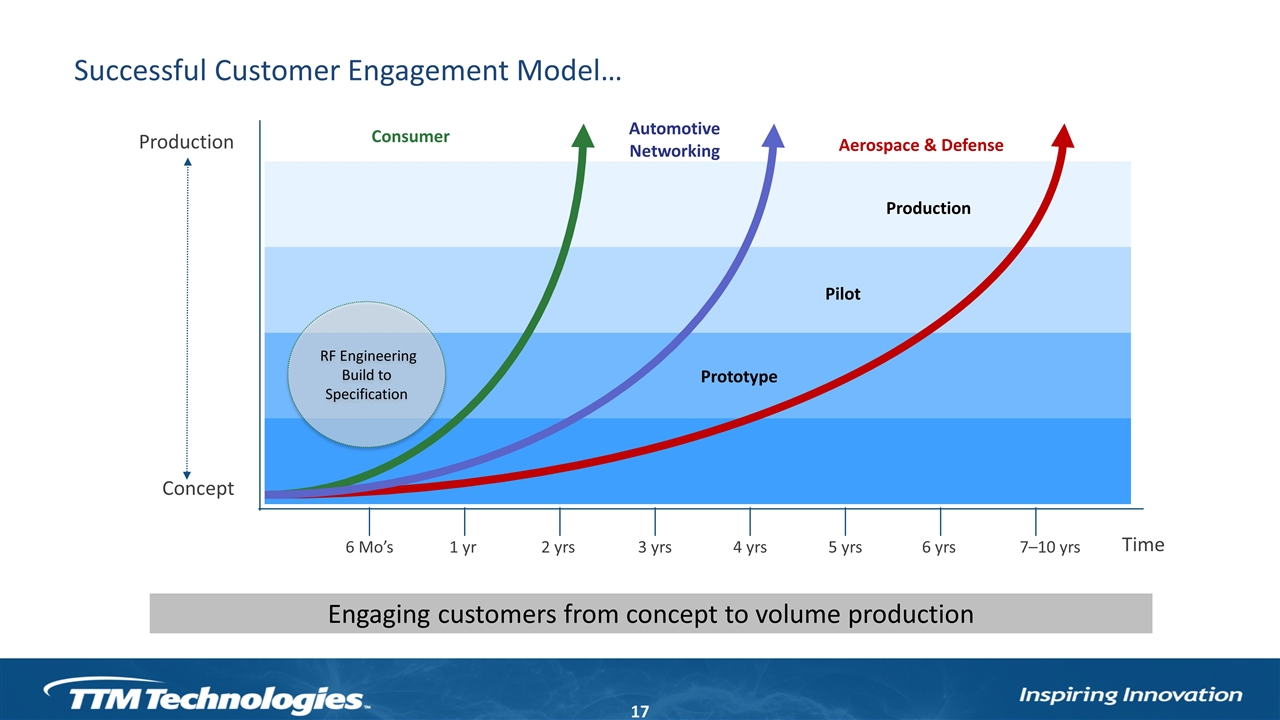
Successful Customer Engagement Model… Engaging customers from concept to volume production Time Concept Production Consumer Aerospace & Defense Automotive Networking Pilot Production Prototype 6 Mo’s 1 yr 2 yrs 3 yrs 4 yrs 5 yrs 6 yrs 7–10 yrs RF Engineering Build to Specification

Global Footprint 7 Salem – SAL Syracuse – SYR 6 26 Suzhou - SUZ Aerospace & Defense 5 Sterling - STE Stafford Springs - SS 4 3 Stafford - ST 1 Denver - DEN 2 North Jackson - NJ Specialty 8 Anaheim - ANA Santa Ana - SA 10 9 Forest Grove - FG 11 Santa Clara - SC San Diego - SD 12 Logan - LG 16 17 San Jose - SJ Toronto - TOR 18 15 Huiyang - HY AMI&I Zhongshan - ZS 13 14 Guangzhou - GZ 29 Shenzhen - SZ 27 Shanghai - SH Shanghai - SH E-MS 28 E-M Solutions A&D Commercial E-MS 23 Chippewa Falls - CF 24 Dongguan - DMC Hong Kong - OPCM 22 C&C Mobility Guangzhou - GME Guangzhou - FPC 19 20 Shanghai - SME Shanghai - SP 21 15 20 21 27 28 1 2 8 9 5 18 3 23 16 17 13 22 19 24 29 12 11 4 10 14 26 6 7 Wireless Syracuse - SYR-W 25 25 Manufacturing facilities divested 4/19/20 No longer part of TTM Manufacturing facilities closing By end of 2020
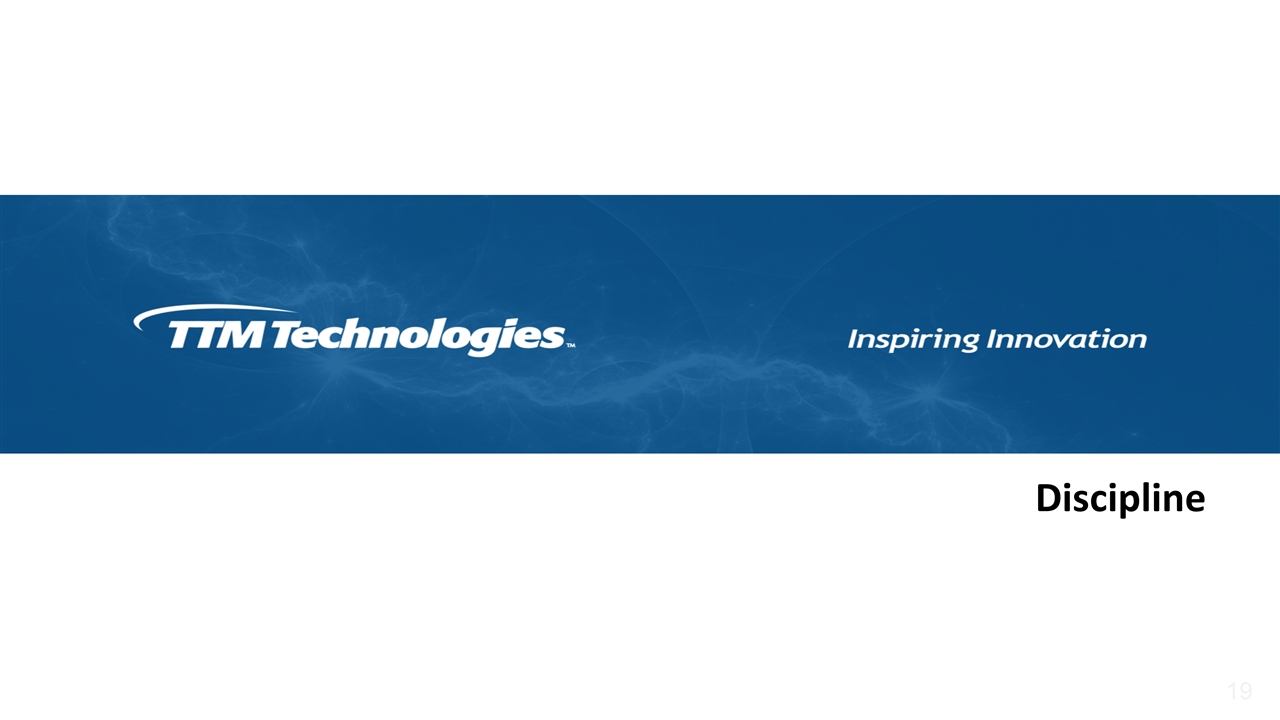
Discipline

Non-GAAP EPS1 Non-GAAP Operating Margin1 Revenues ($ millions) Reported Annual Revenue and Profit Growth Increased scale, diversification, and differentiation 1All TTM financials are reported non-GAAP. See Appendix for reconciliation
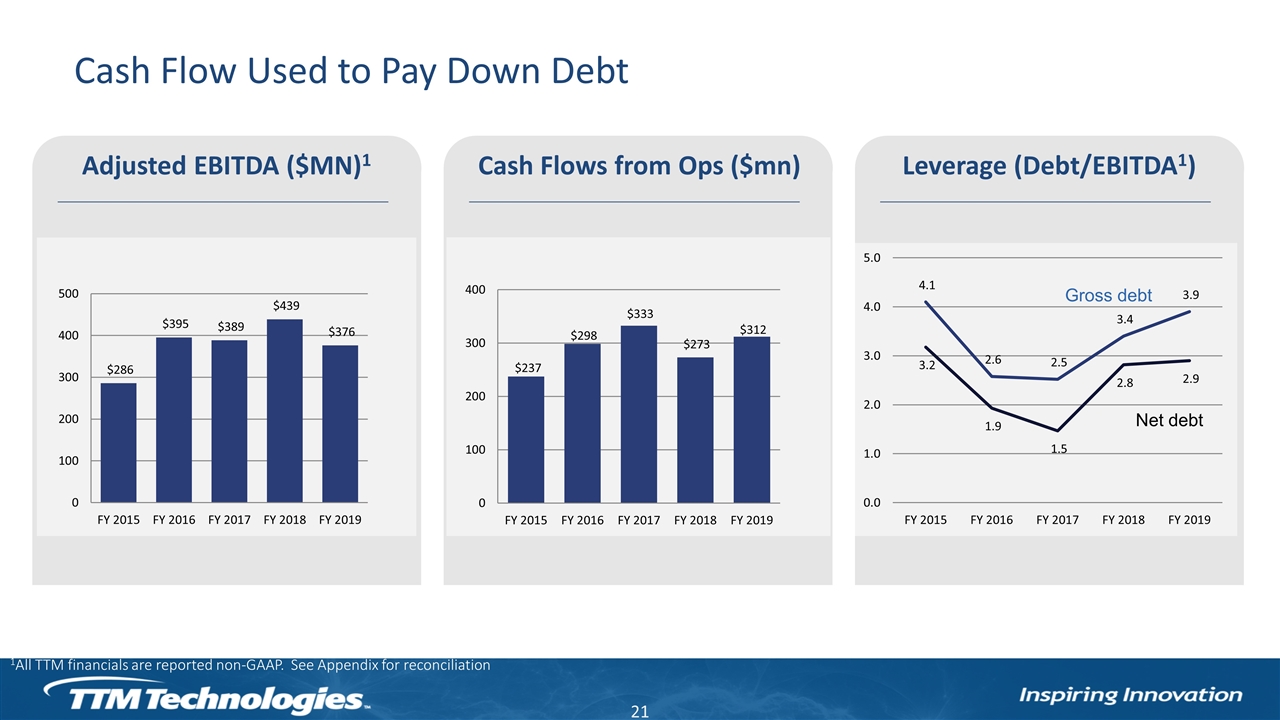
Leverage (Debt/EBITDA1) Cash Flows from Ops ($mn) Adjusted EBITDA ($MN)1 Cash Flow Used to Pay Down Debt Gross debt Net debt 1All TTM financials are reported non-GAAP. See Appendix for reconciliation
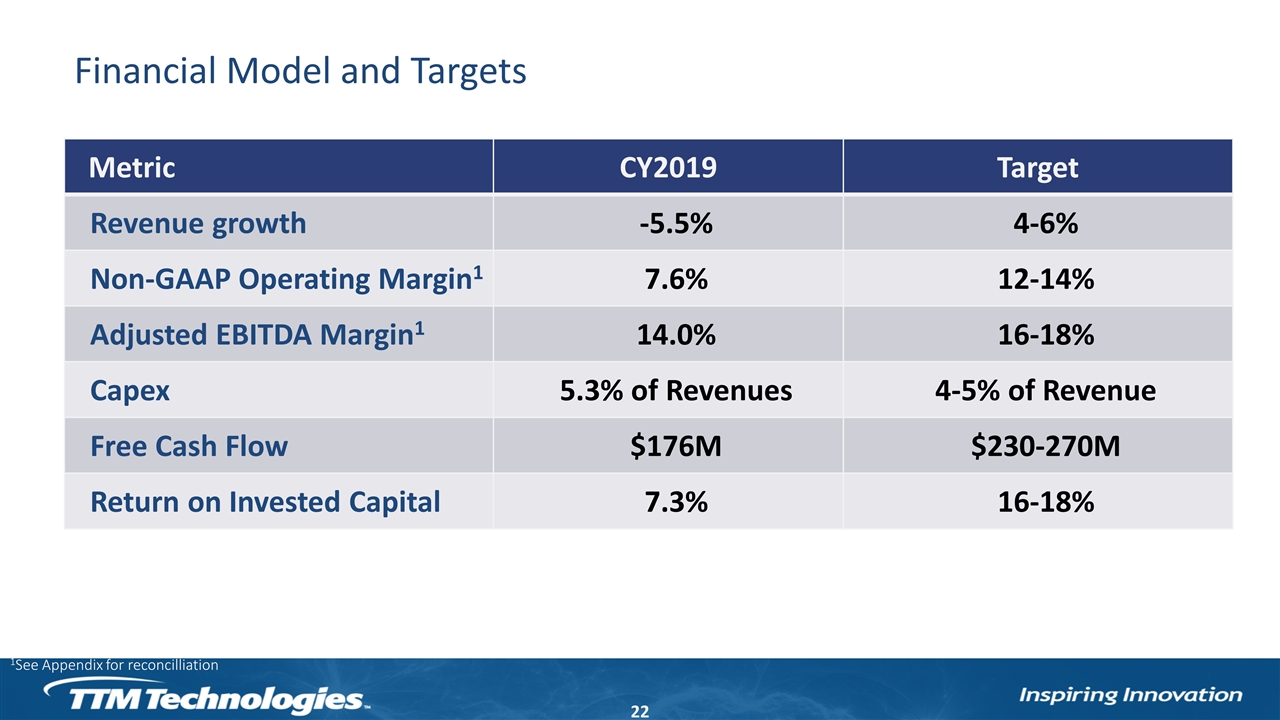
Financial Model and Targets Metric CY2019 Target Revenue growth -5.5% 4-6% Non-GAAP Operating Margin1 7.6% 12-14% Adjusted EBITDA Margin1 14.0% 16-18% Capex 5.3% of Revenues 4-5% of Revenue Free Cash Flow $176M $230-270M Return on Invested Capital 7.3% 16-18% 1See Appendix for reconcilliation

Restructuring of E-MS Business Unit
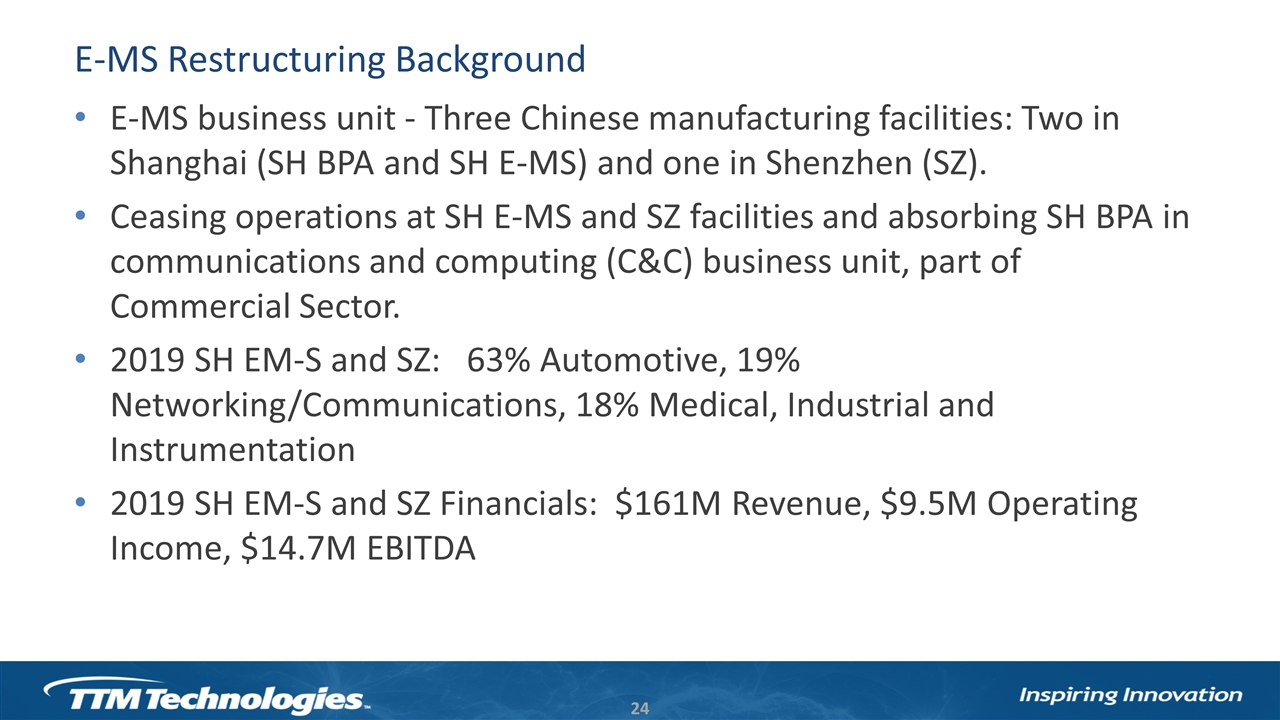
E-MS business unit - Three Chinese manufacturing facilities: Two in Shanghai (SH BPA and SH E-MS) and one in Shenzhen (SZ). Ceasing operations at SH E-MS and SZ facilities and absorbing SH BPA in communications and computing (C&C) business unit, part of Commercial Sector. 2019 SH EM-S and SZ: 63% Automotive, 19% Networking/Communications, 18% Medical, Industrial and Instrumentation 2019 SH EM-S and SZ Financials: $161M Revenue, $9.5M Operating Income, $14.7M EBITDA E-MS Restructuring Background
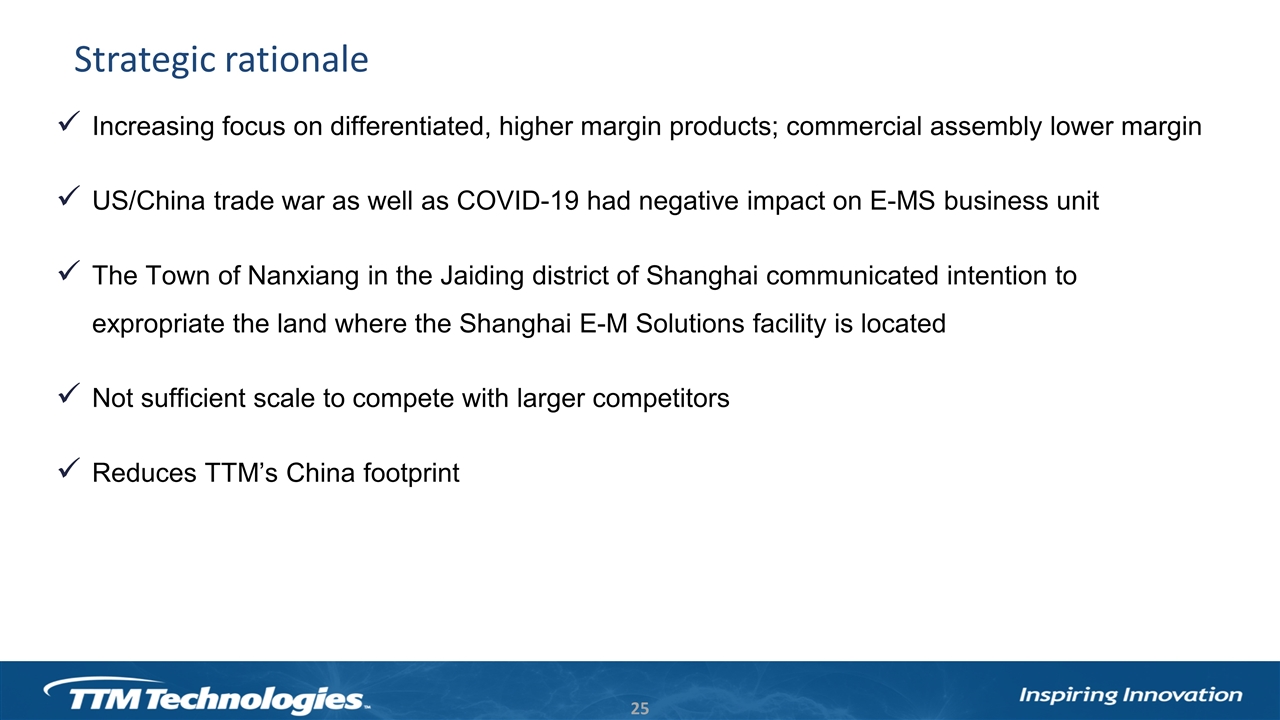
Strategic rationale Increasing focus on differentiated, higher margin products; commercial assembly lower margin US/China trade war as well as COVID-19 had negative impact on E-MS business unit The Town of Nanxiang in the Jaiding district of Shanghai communicated intention to expropriate the land where the Shanghai E-M Solutions facility is located Not sufficient scale to compete with larger competitors Reduces TTM’s China footprint

Divestiture of Mobility Business Unit
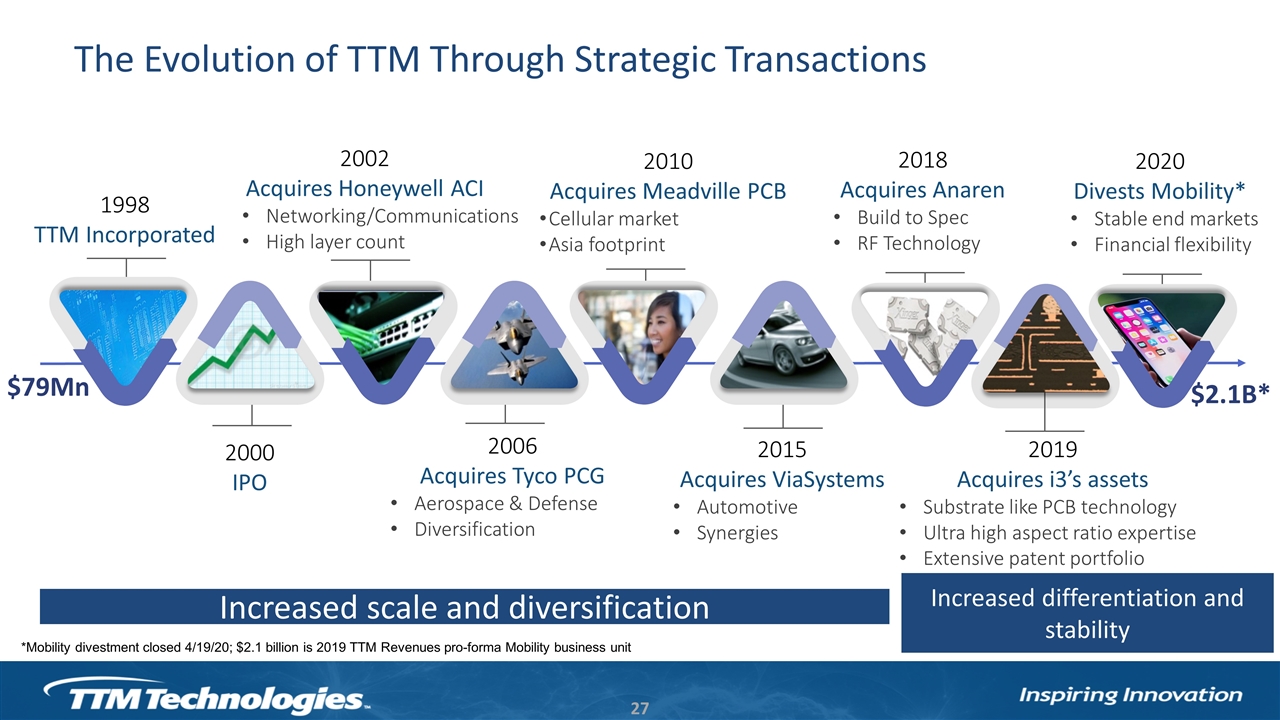
2018 Acquires Anaren Build to Spec RF Technology 2020 Divests Mobility* Stable end markets Financial flexibility 2019 Acquires i3’s assets Substrate like PCB technology Ultra high aspect ratio expertise Extensive patent portfolio $2.1B* $79Mn The Evolution of TTM Through Strategic Transactions 1998 TTM Incorporated 2000 IPO 2002 Acquires Honeywell ACI Networking/Communications High layer count 2006 Acquires Tyco PCG Aerospace & Defense Diversification 2010 Acquires Meadville PCB Cellular market Asia footprint 2015 Acquires ViaSystems Automotive Synergies Increased scale and diversification Increased differentiation and stability *Mobility divestment closed 4/19/20; $2.1 billion is 2019 TTM Revenues pro-forma Mobility business unit
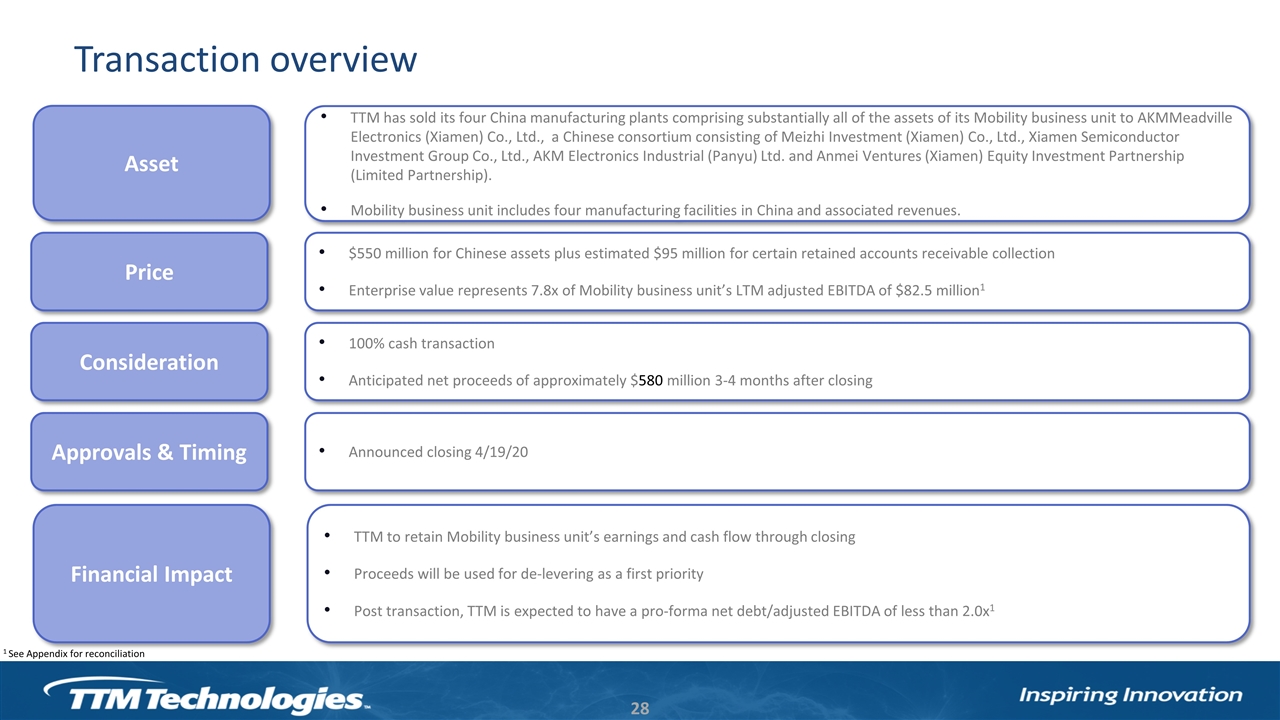
Transaction overview TTM has sold its four China manufacturing plants comprising substantially all of the assets of its Mobility business unit to AKMMeadville Electronics (Xiamen) Co., Ltd., a Chinese consortium consisting of Meizhi Investment (Xiamen) Co., Ltd., Xiamen Semiconductor Investment Group Co., Ltd., AKM Electronics Industrial (Panyu) Ltd. and Anmei Ventures (Xiamen) Equity Investment Partnership (Limited Partnership). Mobility business unit includes four manufacturing facilities in China and associated revenues. Asset Price $550 million for Chinese assets plus estimated $95 million for certain retained accounts receivable collection Enterprise value represents 7.8x of Mobility business unit’s LTM adjusted EBITDA of $82.5 million1 Consideration 100% cash transaction Anticipated net proceeds of approximately $580 million 3-4 months after closing Approvals & Timing Announced closing 4/19/20 Financial Impact TTM to retain Mobility business unit’s earnings and cash flow through closing Proceeds will be used for de-levering as a first priority Post transaction, TTM is expected to have a pro-forma net debt/adjusted EBITDA of less than 2.0x1 1 See Appendix for reconciliation
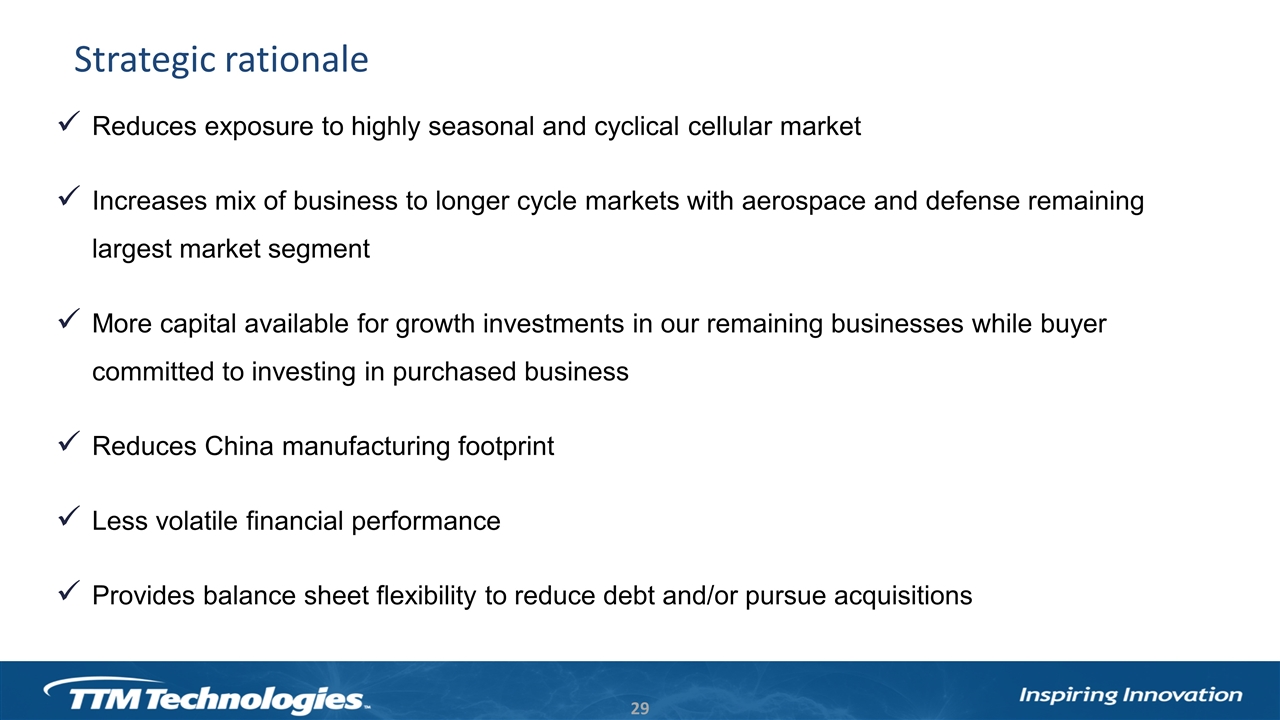
Strategic rationale Reduces exposure to highly seasonal and cyclical cellular market Increases mix of business to longer cycle markets with aerospace and defense remaining largest market segment More capital available for growth investments in our remaining businesses while buyer committed to investing in purchased business Reduces China manufacturing footprint Less volatile financial performance Provides balance sheet flexibility to reduce debt and/or pursue acquisitions
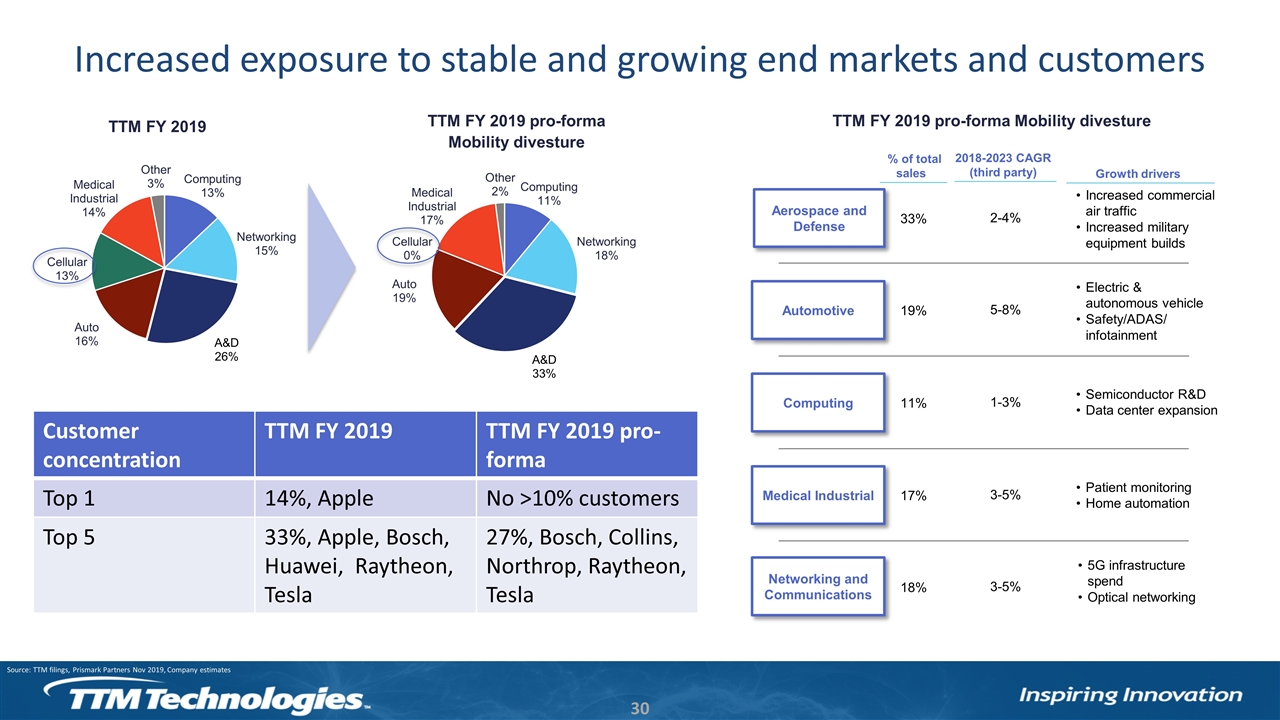
Increased exposure to stable and growing end markets and customers TTM FY 2019 TTM FY 2019 pro-forma Mobility divesture Networking and Communications Aerospace and Defense Medical Industrial Computing Automotive Growth drivers 2018-2023 CAGR (third party) 2-4% 5-8% 1-3% 3-5% 3-5% % of total sales 33% 19% 11% 17% 18% Increased commercial air traffic Increased military equipment builds Electric & autonomous vehicle Safety/ADAS/ infotainment Semiconductor R&D Data center expansion Patient monitoring Home automation 5G infrastructure spend Optical networking TTM FY 2019 pro-forma Mobility divesture Customer concentration TTM FY 2019 TTM FY 2019 pro-forma Top 1 14%, Apple No >10% customers Top 5 33%, Apple, Bosch, Huawei, Raytheon, Tesla 27%, Bosch, Collins, Northrop, Raytheon, Tesla Source: TTM filings, Prismark Partners Nov 2019, Company estimates
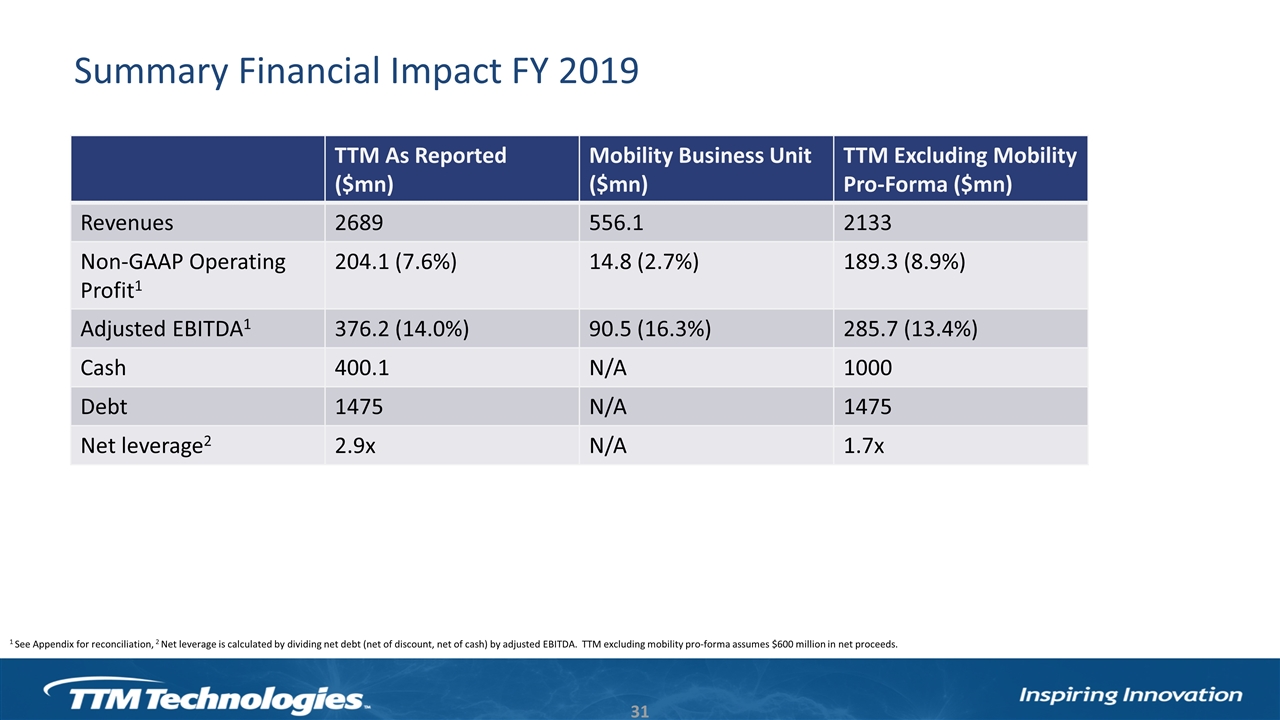
Summary Financial Impact FY 2019 TTM As Reported ($mn) Mobility Business Unit ($mn) TTM Excluding Mobility Pro-Forma ($mn) Revenues 2689 556.1 2133 Non-GAAP Operating Profit1 204.1 (7.6%) 14.8 (2.7%) 189.3 (8.9%) Adjusted EBITDA1 376.2 (14.0%) 90.5 (16.3%) 285.7 (13.4%) Cash 400.1 N/A 1000 Debt 1475 N/A 1475 Net leverage2 2.9x N/A 1.7x 1 See Appendix for reconciliation, 2 Net leverage is calculated by dividing net debt (net of discount, net of cash) by adjusted EBITDA. TTM excluding mobility pro-forma assumes $600 million in net proceeds.
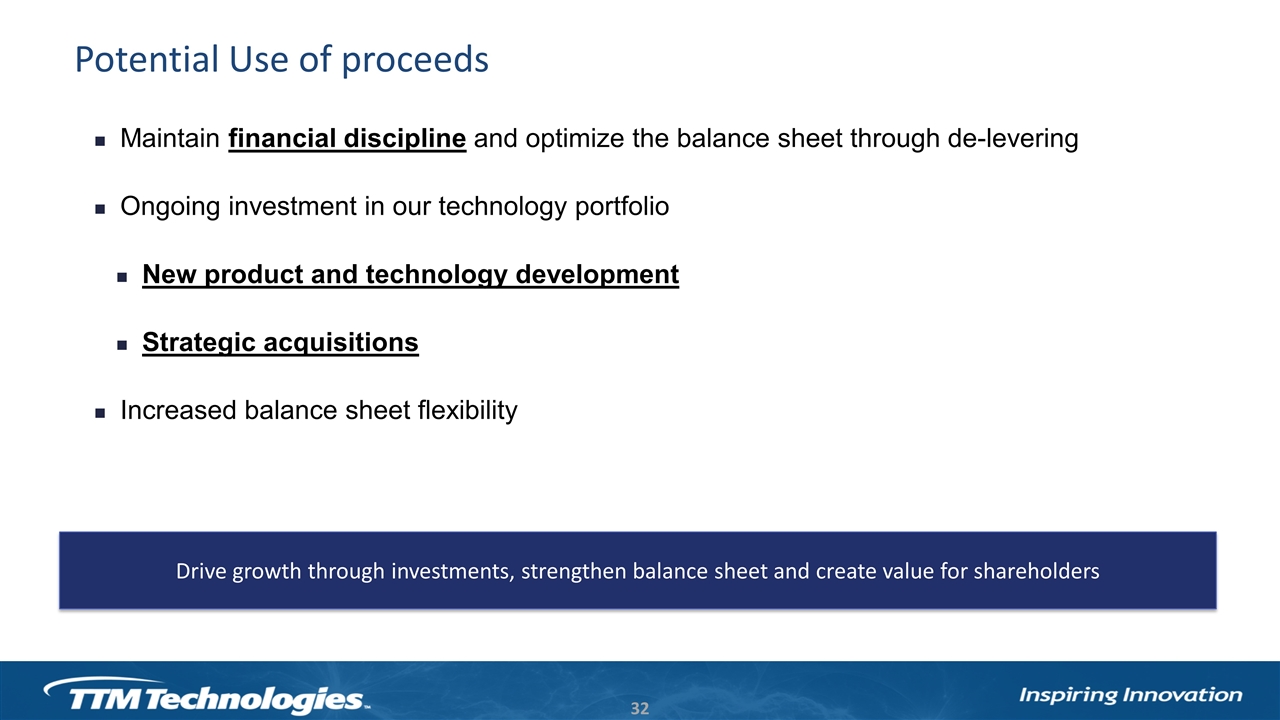
Potential Use of proceeds Drive growth through investments, strengthen balance sheet and create value for shareholders Maintain financial discipline and optimize the balance sheet through de-levering Ongoing investment in our technology portfolio New product and technology development Strategic acquisitions Increased balance sheet flexibility
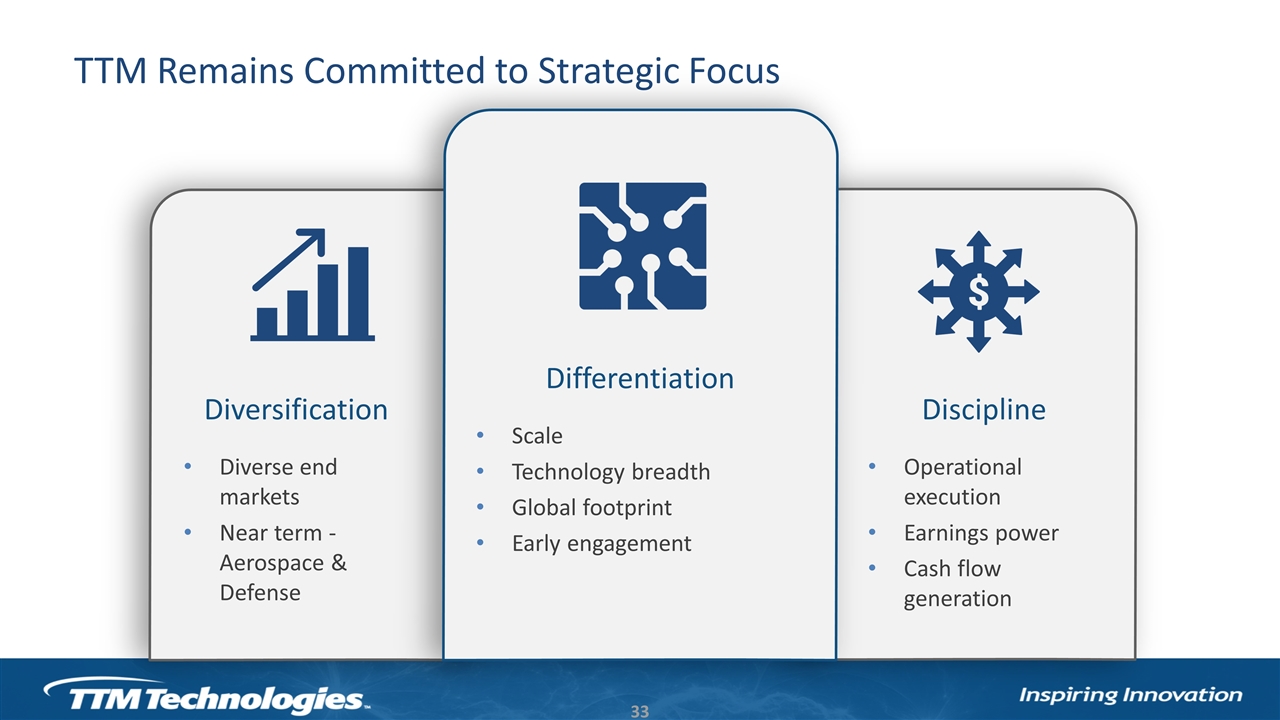
Diversification Diverse end markets Near term -Aerospace & Defense Discipline Operational execution Earnings power Cash flow generation TTM Remains Committed to Strategic Focus Differentiation Scale Technology breadth Global footprint Early engagement
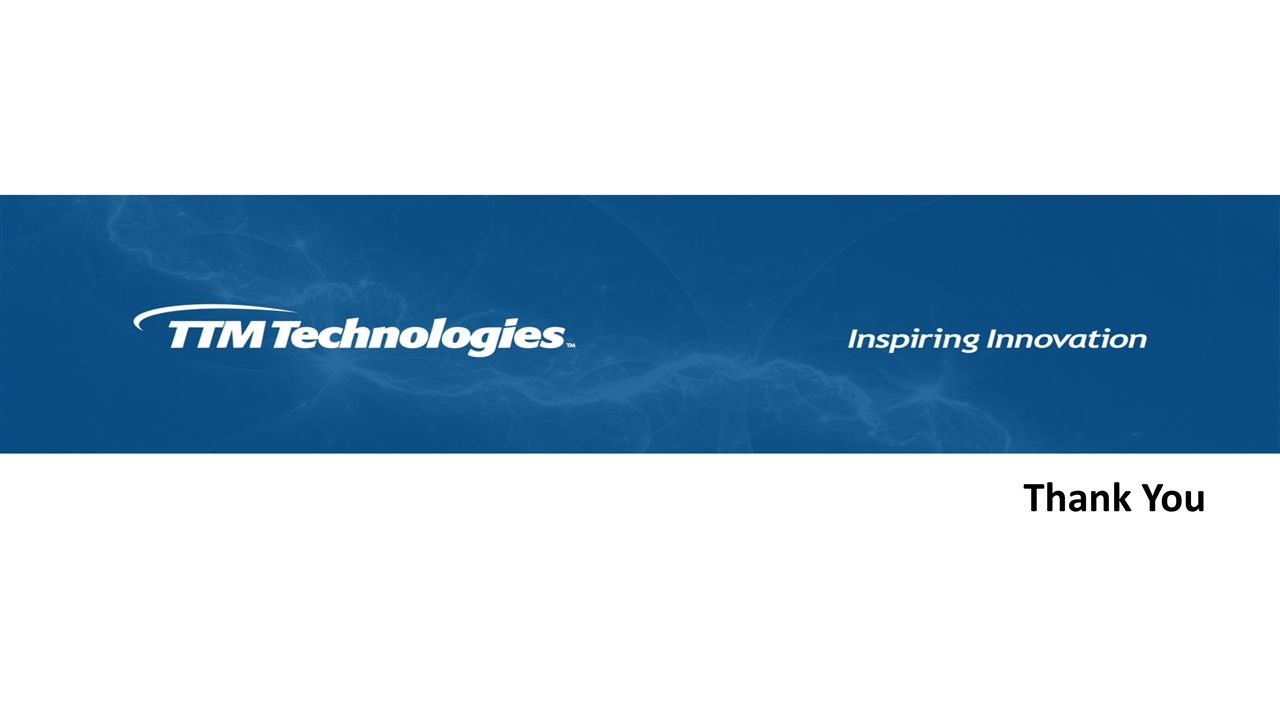
Thank You

Appendix
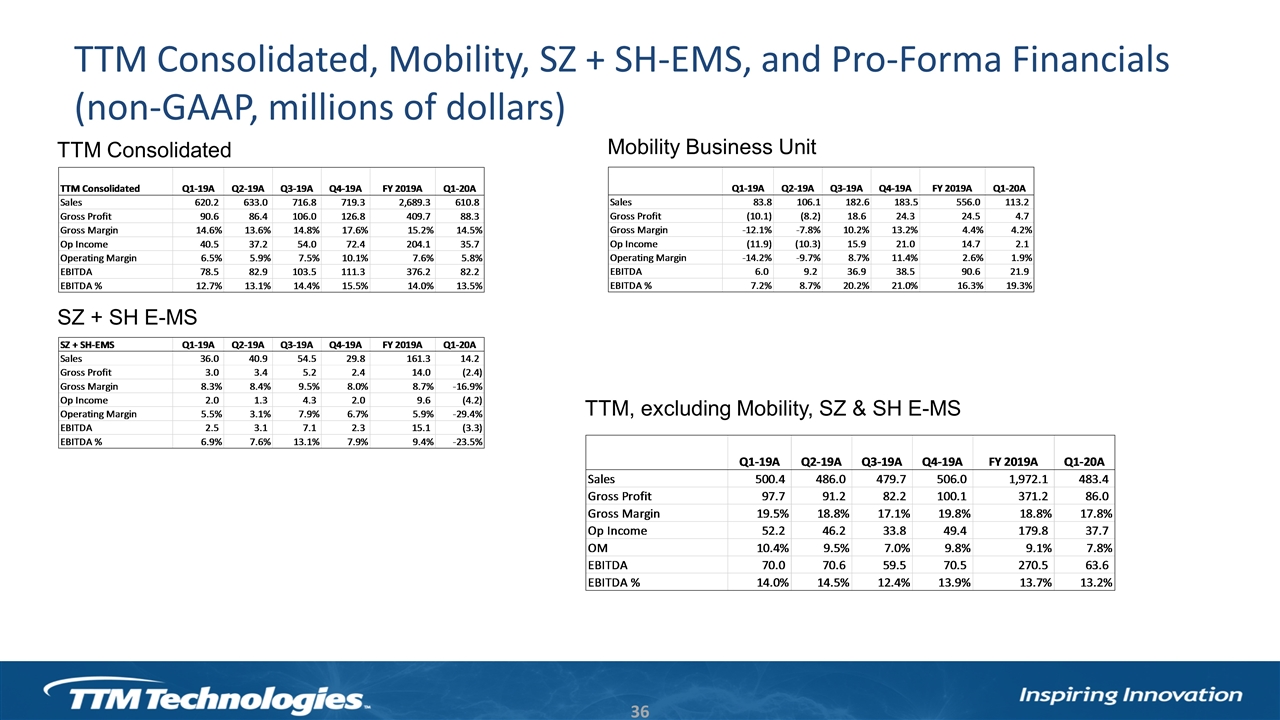
TTM Consolidated, Mobility, SZ + SH-EMS, and Pro-Forma Financials (non-GAAP, millions of dollars) TTM Consolidated Mobility Business Unit SZ + SH E-MS TTM, excluding Mobility, SZ & SH E-MS
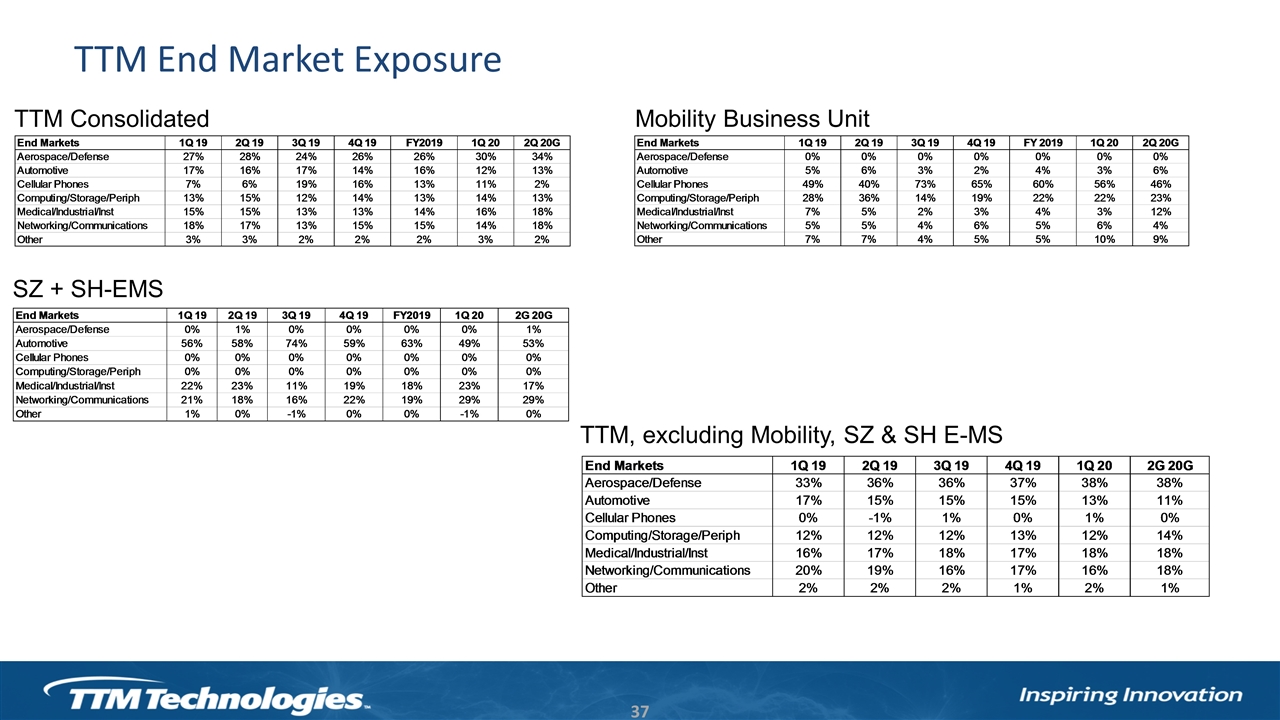
TTM End Market Exposure TTM Consolidated Mobility Business Unit SZ + SH-EMS TTM, excluding Mobility, SZ & SH E-MS
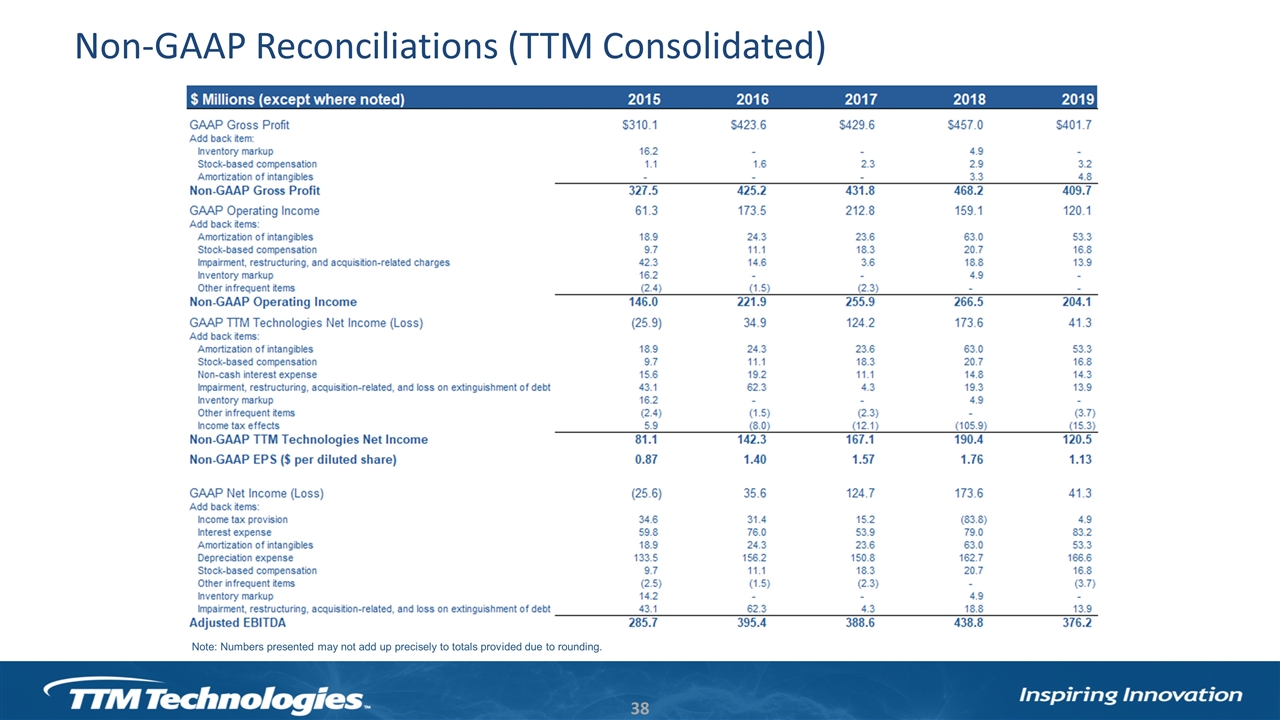
Non-GAAP Reconciliations (TTM Consolidated) Note: Numbers presented may not add up precisely to totals provided due to rounding.
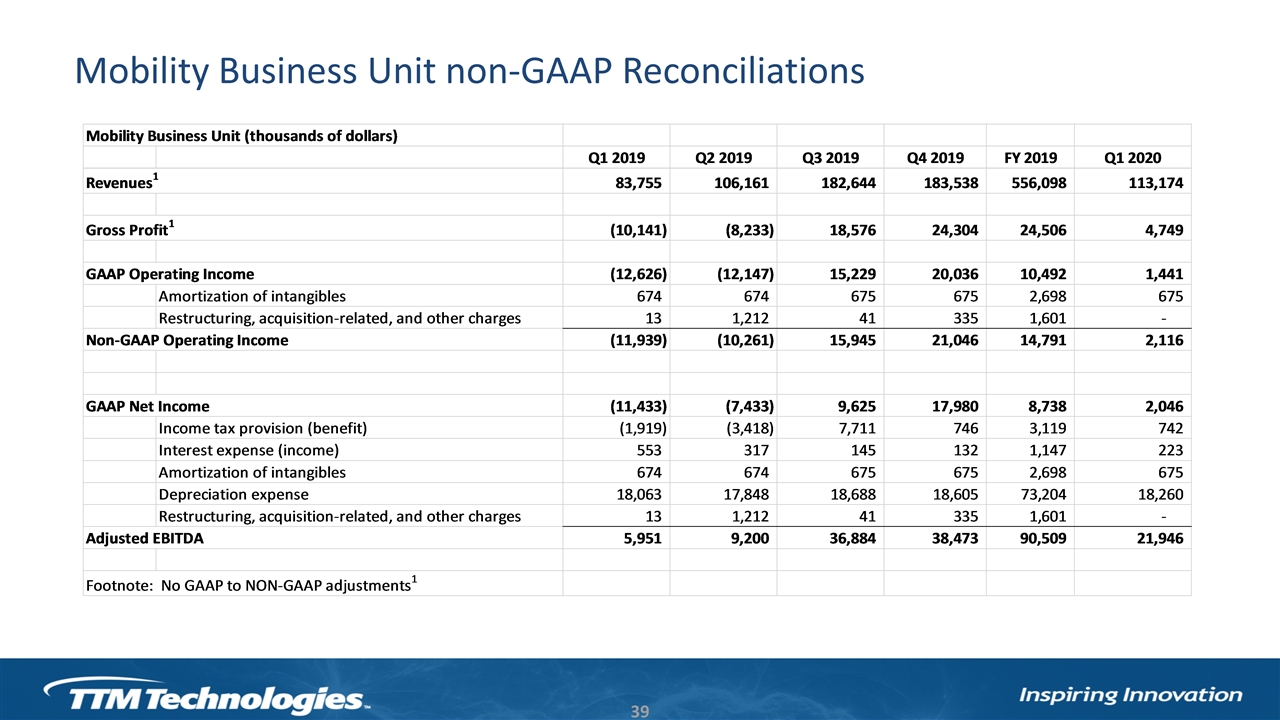
Mobility Business Unit non-GAAP Reconciliations
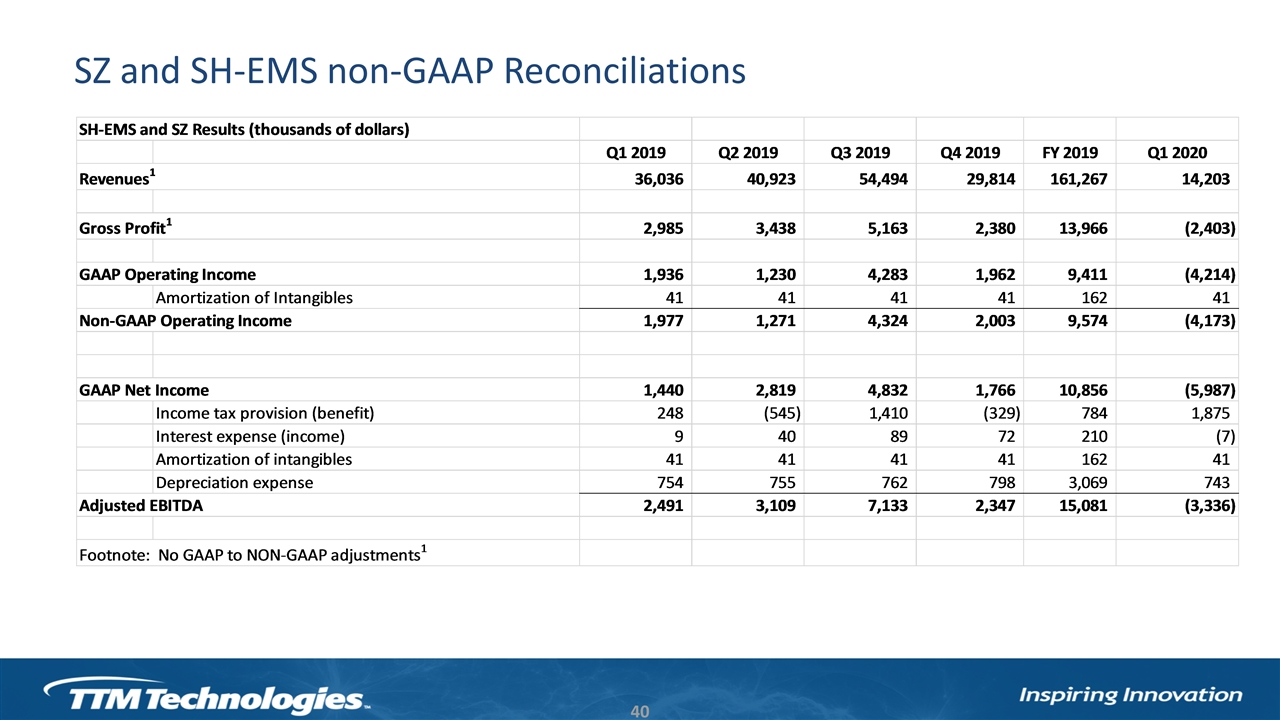
SZ and SH-EMS non-GAAP Reconciliations
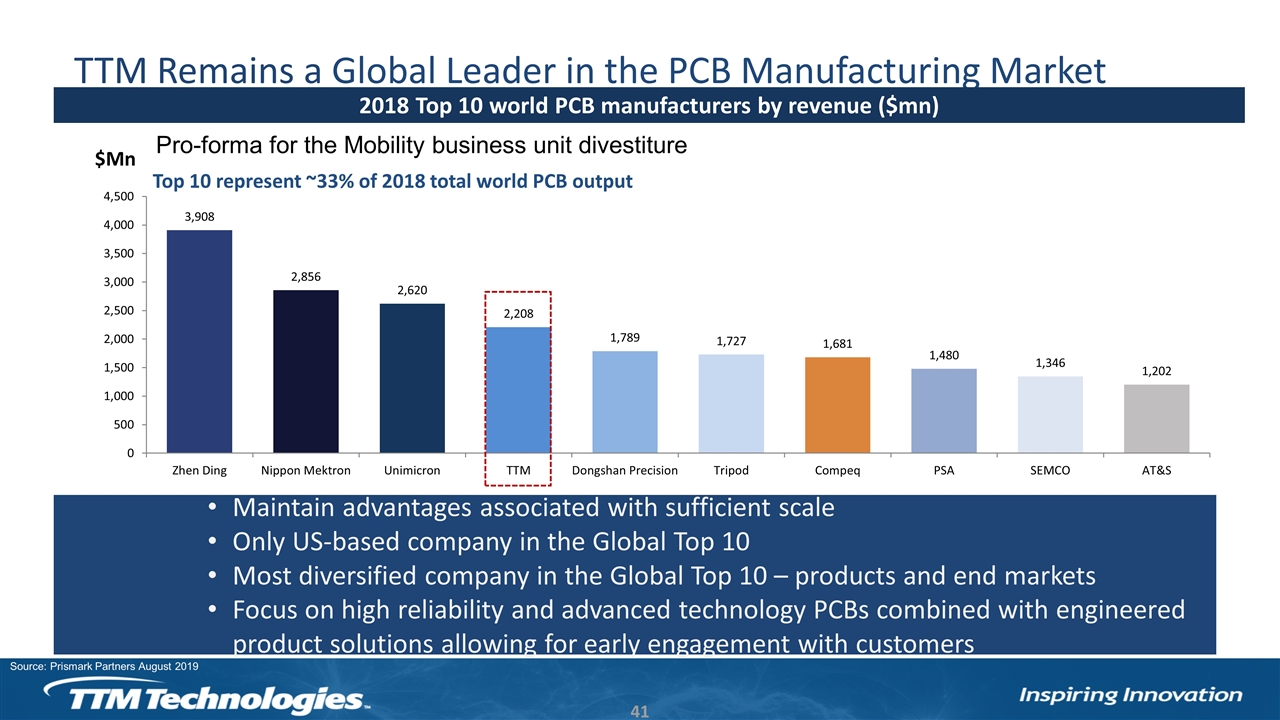
TTM Remains a Global Leader in the PCB Manufacturing Market 2018 Top 10 world PCB manufacturers by revenue ($mn) $Mn Maintain advantages associated with sufficient scale Only US-based company in the Global Top 10 Most diversified company in the Global Top 10 – products and end markets Focus on high reliability and advanced technology PCBs combined with engineered product solutions allowing for early engagement with customers Top 10 represent ~33% of 2018 total world PCB output Source: Prismark Partners August 2019 Pro-forma for the Mobility business unit divestiture